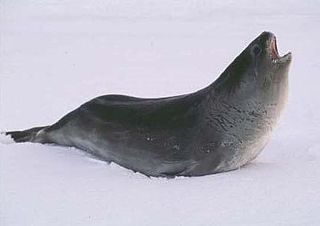
The earless seals, phocids or true seals are one of the three main groups of mammals within the seal lineage, Pinnipedia. All true seals are members of the family Phocidae. They are sometimes called crawling seals to distinguish them from the fur seals and sea lions of the family Otariidae. Seals live in the oceans of both hemispheres and, with the exception of the more tropical monk seals, are mostly confined to polar, subpolar, and temperate climates. The Baikal seal is the only species of exclusively freshwater seal.

The Ross seal is a true seal with a range confined entirely to the pack ice of Antarctica. It is the only species of the genus Ommatophoca. First described during the Ross expedition in 1841, it is the smallest, least abundant and least well known of the Antarctic pinnipeds. Its distinctive features include disproportionately large eyes, whence its scientific name, and complex, trilling and siren-like vocalizations. Ross seals are brachycephalic, as they have a short broad muzzle and have the shortest fur of any other seal.

Desmatophoca is an extinct genus of early pinniped that lived during the Miocene, and is named from the Greek "phoca", meaning seal. A taxon of the family Desmatophocidae, it shares some morphological similarities with modern true seals. Two species are recognized: Desmatophoca oregonensis and Desmatophoca brachycephala. Little information exists regarding Desmatophoca, due to the small number of fossil samples obtained and identified.

Pusa is a genus of the earless seals, within the family Phocidae. The three species of this genus were split from the genus Phoca, and some sources still give Phoca as an acceptable synonym for Pusa.

Phocinae is a subfamily of Phocidae whose distribution is found in the seas surrounding the Holarctic, with the Baikal seal being the world's only freshwater species of pinniped. What distinguishes them from other phocid seals is the presence of well-developed claws on their front and back flippers. The Phocinae is divided into three extant tribes: Erignathini, Cystophorini, and Phocini. Members of both Erignathini and Cystophorini have 34 chromosomes, while species in the tribe Phocini have 32 chromosomes.

Ontocetus is an extinct genus of walrus, an aquatic carnivoran of the family Odobenidae, endemic to coastal regions of the southern North Sea and the southeastern coastal regions of the U.S. during the Miocene-Pleistocene. It lived from 13.6 mya—300,000 years ago, existing for approximately 13.3 million years .

Ptychoceratodus is an extinct genus of prehistoric sarcopterygians or lobe-finned fish originally named as a species of Ceratodus in 1837. It was a lungfish from the Mesozoic era (Triassic-Cretaceous), and the only members of the family Ptychoceratodontidae. One species, P. oldhami, was named in 2018 based on remains from the Carnian-aged Tiki Formation (India). The first named species, which is also the type species, is P. phillipsi, which was named in 1837 by Louis Agassiz as a species of Ceratodus and moved to a separate genus in 1926.
Leptophoca is an extinct genus of earless seals from the North Atlantic realm.
Plesiocetus is a genus of extinct balaenopterids found worldwide. It has had a chequered taxonomic history, having served as a wastebasket genus for a handful of mysticete species.
Monotherium is an extinct genus of phocid belonging to the subfamily Monachinae. It is known from fossils found in the middle to late Miocene of Belgium.

Pliophoca is an extinct genus of seal in the family Phocidae.
Nanophoca is an extinct genus of earless seals from the middle Miocene of Belgium.
Phocanella is an extinct genus of earless seals from the early Pliocene of Belgium and the US Eastern Seaboard.
Platyphoca is an extinct genus of earless seals from Neogene marine deposits in the North Sea basin.
Gryphoca is an extinct genus of earless seals from Neogene marine deposits in the North Sea basin.
Callophoca is an extinct genus of earless seals from the late Miocene to early Pliocene of Belgium and the US Eastern Seaboard.
Noriphoca is an extinct genus of phocid belonging to the subfamily Monachinae. It is known from the late Oligocene to early Miocene of Italy.
Auroraphoca is an extinct genus of earless seals from the early Pliocene of what is now the U.S. Eastern Seaboard.

Monachinae is a subfamily of Phocidae whose distribution is found in the tropical, temperate and polar regions of the southern hemisphere, though in the distant past fossil representatives have been found on both sides of the North Atlantic Ocean. The difference between members of this group and members of Phocinae is in monachines the hindclaws are greatly reduced in size. Furthermore, all species have 34 chromosomes. There are three tribes recognized here: Monachini, Miroungini, and Lobodontini. While today represented by eight extant and one recently extinct species, Monachinae had an incredibly enriched fossil diversity that went into decline soon to be replaced by southern species of sea lions and fur seals.












